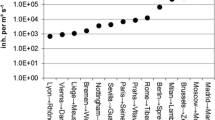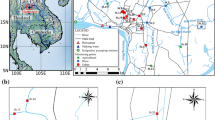Abstract
Insufficient wastewater remediation in small communities and nonpoint source pollution are the key factors in determining the water quality of small streams in an agricultural landscape. Despite the current extensive construction of municipal wastewater treatment facilities in small communities, the level of organic substances and nutrients in the recipient catchments has not decreased in many areas. This paper analyzes the changes in the water quality of the small streams after the deployment of wastewater treatment plants that were designed to address sources of pollution from small municipalities. The analysis is based on the results from a water quality monitoring network in the small watersheds in the Czech Republic. Five rural catchments with one dominant municipal pollution source, where a wastewater treatment plant was deployed during the monitoring period, were selected according to a predefined set of criteria, from a series of 317 profiles. Basic water quality indicators were selected for the assessment: O2, BOD-5, COD, TOC, conductivity, NH4-N, NO2-N, NO3-N, PT, and PO4-P. Results of the analysis showed that the simple deployment of the water treatment facilities at these streams often did not lead to a reduction of contamination in the streams. The expected post-deployment changes, namely, a significant and permanent reduction of stream contamination, occurred only in one catchment, whereas in the remainder of the catchments, only marginal changes or even increased concentrations of the contaminants were detected. As the critical factors that determined the efficiency of wastewater treatment were studied, the need for the consideration of the local conditions during the design of the facility, particularly regarding the size of the catchments, initial level of contamination, proper system of operation, and process optimization of the treatment facility, emerged as the important factor.





Similar content being viewed by others
References
Alamets, K., Bicanová, M., Judová, P., Pärnamets, H., Ronczyk, L., & Rödlová, S. (2004). Water quality changes and its trends in the Czech Republic. Geografie, 109(2), 181–8.
ARBA. (2011). Monitoring of water quality on small streams database. Prague: Agricultural River Basin Authority.
Barjenbruch, M., & Exner, E. (2012). Comparative study of small wastewater treatment technologies under special operation conditions—COMPAS. Desalination and Water Treatment, 39(1–3), 278–83.
Benedetti, L., Dirckx, G., Bixio, D., Thoeye, C., & Vanrolleghem, P. A. (2008). Environmental and economic performance assessment of the integrated urban wastewater system. Journal of Environmental Management, 88(4), 1262–72.
Behrendt, H., Kornmilch, M., Opitz, D., Schmoll, O., & Scholz, G. (2002). Estimation of the nutrient inputs into river systems—experiences from German rivers. Regional Environmental Change, 3(1–3), 107–17.
Boller, M. (1997). Small wastewater treatment plants—a challenge to wastewater engineers. Water Science and Technology, 35(6), 1–12.
Bradley, B., Daigger, G., Rubin, R., & Tchobanoglous, G. (2002). Evaluation of onsite wastewater treatment technologies using sustainable development criteria. Clean Technologies and Environmental Policy, 4, 87–99.
Brion, N., Billen, G., Guézennec, L., & Ficht, A. (2000). Distribution of nitrifying activity in the Seine River (France) from Paris to the estuary. Estuaries and Coasts, 23(5), 669–82.
CHMI (2012). Arrow—surface water quality monitoring database. Czech Hydrometeorological Institute. http://hydro.chmi.cz/isarrow/index.php?lng=eng. Accessed 25 Jul 2012
CSO (2012). Czech Statistical Office—public database. http://vdb.czso.cz/vdbvo/en/uvod.jsp. Accessed 10 Aug 2012
De Wit, M., & Behrendt, H. (1999). Nitrogen and phosphorus emissions from soil to surface water in the rhine and elbe basins. Water Science and Technology, 39(1), 109–16.
EC (2000). Directive 2000/60/EC of the European Parliament and of the Council of 23 October 2000 establishing a framework for community action in the field of water policy. Official Journal of the European Communities 22(12), 2000.
EEA. (1998). Oxygen demand at river stations by river size and catchment type. Distribution (vol. 5, pp. 1–16). EEA: Copenhagen.
EEA (2001). Nitrogen and phosphorus in river stations by river size and catchment type. http://www.eea.europa.eu/data-and-maps/indicators/ammonium-concentrations-in-rivers. Accessed 21 Jun 2012
EEA (2012). CORINE landcover database. http://www.eea.europa.eu/publications/COR0-landcover. Accessed 2 Jun 2012
Finnegan, C. J., Van Egmond, R. A., Price, O. R., & Whelan, M. J. (2009). Continuous-flow laboratory simulation of stream water quality changes downstream of an untreated wastewater discharge. Water Research, 43(7), 1993–2001.
Fučík, P., Lexa, M., & Novák, P. (2008). Assessing the stream water quality dynamics in connection with land use in agricultural catchments of different scales. Soil and Water, 2008(3), 98–112.
Garcia, J., Mujeriego, R., Obis, J. M., & Bou, J. (2001). Wastewater treatment for small communities in Catalonia (Mediterranean region). Water Policy, 3(4), 341–50.
Gašpariková, E., Kapusta, Š., Bodίk, I., Derco, J., & Kratochvíl, K. (2005). Evaluation of anaerobic-aerobic wastewater treatment plant operations. Polish Journal of Environmental Studies, 14(1), 29–34.
Haggard, B. E., Storm, D. E., & Stanley, E. H. (2001). Effect of a point source input on stream nutrient retention. JAWRA Journal of the American Water Resources Association, 37(5), 1291–9.
Hering, D., Borja, A., Carstensen, J., Carvalho, L., Elliott, M., Feld, C. K., et al. (2010). The European Water Framework Directive at the age of 10: a critical review of the achievements with recommendations for the future. Science of the Total Environment, 408(19), 4007–19.
Judová, P., & Janský, B. (2005). Water quality in rural areas of the Czech Republic: key study Slapanka River catchment. Limnologica, 35(3), 160–8.
Knauer, N., & Mander, Ü. (1989). Untersuchungen über die Filterwirkung verschiedener Saumbiotope an Gewässern in Schleswig-Holstein. 1. Mitteilung: Filterung von Stickstoffund Phosphor. Zeitschrift füer Kulturtechnik und Landentwicklung, 30, 365–76.
Langhammer, J. (2010). Water quality changes in the Elbe River basin, Czech Republic, in the context of the post-socialist economic transition. GeoJournal, 75(2), 185–98.
Langhammer, J., Hartvich, F., Mattas, D., Rödlová, S., & Zbořil, A. (2012). The variability of surface water quality indicators in relation to watercourse typology, Czech Republic. Environmental Monitoring and Assessment, 184(6), 3983–99.
Line, D. E. (2013). Effect of development on water quality for seven streams in North Carolina. Environmental Monitoring and Assessment. doi:10.1007/s10661-012-3024-z.
Liu, W. B., & Chen, D. M. (2009). Spatial impact of organic matters from point sources on stream water quality. Mining Science and Technology (China), 19(2), 256–61.
Marti, E., Aumatell, J., Godé, L., Poch, M., & Sabater, F. (2004). Nutrient retention efficiency in streams receiving inputs from wastewater treatment plants. Journal of Environmental Quality, 33(1), 285–93.
Massoud, M. A., Tareen, J., Tarhini, A., Nasr, J., & Jurdi, M. (2010). Effectiveness of wastewater management in rural areas of developing countries: a case of Al-Chouf Caza in Lebanon. Environmental monitoring and assessment, 161(1–4), 61–69.
Meloun, M., & Militky, J. (2011). Statistical data analysis: a practical guide (p. 800). Sawston: Woodhead Publishing, Limited.
Merseburger, G. C., Martí, E., & Sabater, F. (2005). Net changes in nutrient concentrations below a point source input in two streams draining catchments with contrasting land uses. Science of the Total Environment, 347, 217–29.
Oliveira, S. C., & Von Sperling, M. (2008). Reliability analysis of wastewater treatment plants. Water Research, 42(4), 1182–94.
OPE (2012). The Operational Programme “Environment”, Czech Republic. A guide to grants under the Operational Programme “Environment”. http://en.opzp.cz/sekce/510/priority-axis-4/. Accessed 11 May 2012
Peterson, B. J., Wollheim, W. M., Mulholland, P. J., Webster, J. R., Meyer, J. L., Tank, J. L., et al. (2001). Control of nitrogen export from watersheds by head water streams. Science, 292(5514), 86–90.
Pitter, P. (1999). Hydrochemie. VŠCHT, Praha. 568 pp. [Hydrochemistry, in Czech]
Rödlová, S. (2006). Surface water quality in small catchment areas after the construction of wastewater treatment plants. Publicationes Instituti Geographica Universitatis Tartuensis, 101(1), 106–12.
Sharpley, A. N., Rekolainen, S., Tunney, H., Carton, O. T., Brookes, P. C., Johnston, A. E. (1997). Phosphorus in agriculture and its environmental implications. Phosphorus loss from soil to water. Proceedings of a workshop, Wexford, Irish Republic, 29–31 September 1995. (pp. 1–53). Cab International.
Siegl, A., Bruch, I., Mühl, M. (1997). Gestaltung von Abwasserbehandlungsanlagen im ländlichen Raum: unter besonderer Berücksichtigung landschaftsökologischer Gesichtspunkte und der Erstellung von Planungs-, Bewertungs- und Entscheidungshilfen. Länderarbeitsgemeinschaft Wasser (LAWA). Abschlußbericht Projekt A (vol. 5, p. 155). Saarbrücken: Ministerium für Umwelt, Energie und Verkehr des Saarlandes.
Sojka, J. (2004). Malé čistírny odpadních vod. Brno: ERA. 98 pp. [Small wastewater treatment plants, in Czech]
Soo, S. S. T., Toh, E. L., Yap, K. K. K., Ng, D. K. S., & Foo, D. C. Y. (2013). Synthesis of distributed wastewater treatment networks for one- and two-contaminant systems. Chemical Engineering Research and Design, 91, 106–19.
Sýkora, L., & Ouředníček, M. (2007). Sprawling post-communist metropolis: commercial and residential suburbanization in Prague and Brno, the Czech Republic. In E. Razin, M. Dijst, & C. Vazquez (Eds.), Employment deconcentration in European metropolitan areas market forces versus planning regulations (Vol. 91, pp. 209–233). Dordrecht: Springer.
Thyssen, N. (2001). Rivers in the European Union: water quality, status and trends. River restoration in Europe. In: H.J. Nijland & M.J.R. Cals (Eds.) Practical approaches, conference on river restoration—proceedings (pp. 66–71). Wageningen, The Netherlands.
Wagner, I., & Zalewski, M. (2009). Ecohydrology as a basis for the sustainable city strategic planning: focus on Lodz, Poland. Reviews in Environmental Science and Biotechnology, 8(3), 209–17.
Wang, Y. P., & Smith, R. (1994). Design of distributed effluent treatment systems. Chemical Engineering Science, 49, 3127–45. doi:10.1016/0009-2509(94)E0126-B.
WRI (2012). HEIS—Hydroecological Information System, Water Research Institute, Prague. http://www.chmi.cz/portal/dt?portal_lang=en&nc=1&menu=JSPTabContainer/P1_0_Home. Accessed 18 Jun 2012
Acknowledgments
The research presented in this paper was supported by Charles University in Prague Research Center UNCE 204003/2012 and by Research Program PRVOUK P43 with the support of Research Plan MSM 0021620831 (“Geographic Systems and Risk Processes in the context of global changes and European integration”).
Author information
Authors and Affiliations
Corresponding author
Rights and permissions
About this article
Cite this article
Langhammer, J., Rödlová, S. Changes in water quality in agricultural catchments after deployment of wastewater treatment plant. Environ Monit Assess 185, 10377–10393 (2013). https://doi.org/10.1007/s10661-013-3339-4
Received:
Accepted:
Published:
Issue Date:
DOI: https://doi.org/10.1007/s10661-013-3339-4




